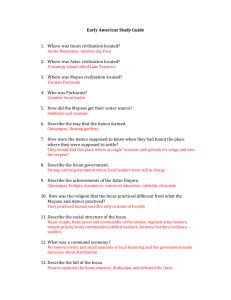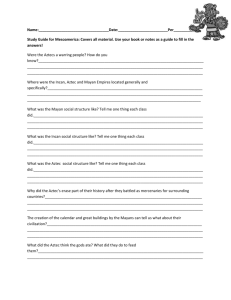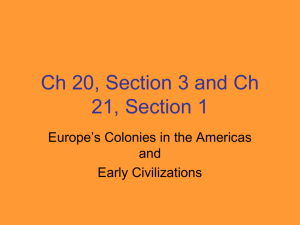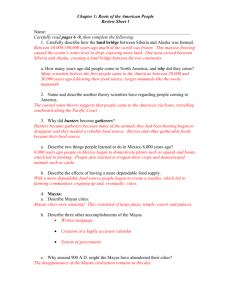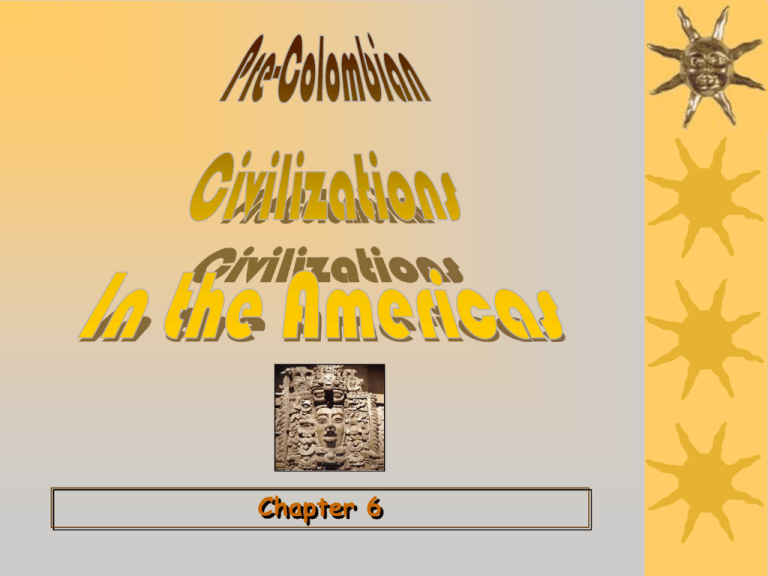
Chapter 6
Early Human
Migrations
Major Pre-Colombian
Civilizations
Early Civ in the Americas
2 centers of early civ in the Americas (Olmec
and Inca) developed in total isolation from
developments elsewhere in the world, so they
lacked certain advantages that come from the
ability to copy and react to other societies.
Lacked tech. like the wheel and iron working,
but they were considerably ahead of Europe
during the same time.
Demonstrate common tendency of humans to
move from agriculture to est. civ.
The Olmec
The earliest American civilization (600-400
B.C.E.) developed along the Mexican Gulf
Coast simultaneously w/ classical world,
though in isolation.
Provided Central America w/ equivalent of
river valley civ in Asia & Mid East.
Cultivation of maize.
Olmecs did not build cities, but ceremonial
centers made up of pyramid-shaped temples
and other buildings (inspired Mayans).
Influence spread through trade.
Mysteries of the Olmecs
Olmecs did not develop writing, so
archaeologists know very little else about the
Olmecs. However, they know from the tombs
and temple ruins that priests and aristocrats
stood at the top of Olmec society.
The most famous remains of Olmec
civilization are the giant carved stone heads at
La Venta. No one knows how they moved
these 40-ton stones from distant quarries
without wheeled vehicles.
Olmecs disappeared w/o a trace around 400
B.C.E., but Maya successors soon evolved.
Colossal Olmec Heads
Lands of the
Mayans
The Yucatan
Peninsula
About the Mayans…
300-900 A.D.
Mayans lived in what is now southern Mexico
and Guatemala. Yucatan Peninsula.
Influenced by their predecessors, the Olmecs.
Descendents of the Mayans still live today in
Guatemala.
Mayan Society
The Mayan Empire was made up of city-states. Each
had its own chief, or king. He was assisted by nobles
who served as military chiefs, and officials who
managed public works, collected taxes, and enforced
laws.
Rulers were usually men, but some women governed
on behalf of their sons.
Priests were very powerful b/c only they could
conduct religious ceremonies needed to ensure good
harvest and success in war. Used pyramid temples
like this one:
Ms. Barton’s Brainchild:
Chichen-Itza Pizza
The importance of
pyramid temples
Priests climbed to the top of the temple to
make sacrifices as people watched from below.
Also served as burial places for nobles and
priests
Mayan pyramids at Tikal were tallest
structures in the Americas until 1903 when
Flatiron Building was built in NYC.
Religious Syncretism Today:
Mashimone: The divine
intermediary whom the
indigenous people of
Antigua go through to
ensure their prayers to God
are answered. In exchange
for answering your prayers
you must give him money,
cigarettes and shots of rum.
The candles at his feet mean
different things. Black
magic.
Advances in Learning
Mayan priests needed to measure time
accurately in order to hold ceremonies at the
right time. Therefore, many priests became
mathematicians and astronomers.
Developed and accurate 365-day solar
calendar.
Invented numbering system and understood
concept of zero.
Chichen-Itza
Astronomical
Observatory
Pakal: The Maya
Astronaut
Quetzalcoatl:
The God of Wisdom &
Learning
Mayan
Glyphs
Advances in Learning
Mayans developed a hieroglyphic writing
system.
Mayan scribes kept sacred knowledge in books
made of bark. Spanish conquerors later burned
many of these books, but a few were taken to
European museums.
Mayan
Glyphs
sky
king
house
child
Mayan
Mathematics
city
Chichen-Itza - Ball
Court
Mayan Ball Games
Spectators watched as 2 teams competed to
drive a rubber ball through a stone ring that
hung from a wall. Opposing players moved the
ball using their bodies, but not their hands and
feet. Similar to soccer, which is modern
Mexico’s most popular spectator sport.
Mayan Cultivation
of Maize
Chac, God of Rain
Importance of Farming (Maize)
Most Mayans were farmers.
Mayan farmers cleared the rain forests and built fields
that held and drained rainwater.
With their advanced system of farming, Mayans
cultivated maize (corn), beans, and squash to support
the heavily populated cities.
Farmers paid taxes in food: helped build temples.
Mayan Underground
Granaries: Chultunes
Overview of Tikal
Temple of the Masks
(Guatemala)
My sister’s photos of Mayan ruins
Tikal Jungle View at
Sunset
My sister zip-lining through
that jungle
Tikal - Main Court
Tikal: Temple of the Masks
My sister
<Laura
Tikal - Wall Mask of the
Rain God
Modern Mayan artist
Mayan Drinking Cup
for Chocolate
Mayans Today
A Mayan woman and
child in Antigua,
Guatemala. Photo
complements of my sis.
Modern Mayans in traditional textiles
Toltecs
Maya civ collpased around the 8th c C.E.
Nomads in n. Yucatan took advantage of
political vacuum to move into richer lands.
Among them was the Toltecs. Toltec
accomplishments often confused with Mayan
and Aztecs.
Toltec Empire lasted until 1150 when Aztecs
rose to power.
Lands of the
Aztecs
Arrival of Aztecs in Valley of Mexico
In the late 1200s, nomads migrated into the
Valley of Mexico from the north. Would
become known as the the Mexica or Tenocha
people. Better known as Aztecs.
According to Aztec legend, the gods told them
to search for an eagle perched on top of a
cactus holding a snake in its beak. They found
it on a swampy island in Lake Texcoco. It was
here that they built the capital city of
Tenochititlan (modern Mexico City), founded
about 1325.
The
Codex
Mendo
za :
The
Foundi
ng
Aztec View of
Tenochtitlan
Ruins of the City Center,
Tenochtitlan
Tenochtitlan: The Venice of
the Americas
Spread of the Aztec Empire
In the 1400s, the Aztecs expanded their empire
throughout most of Mexico. Their methods of
conquest included fierce warfare, and shrewd
alliance.
By 1500, there were 30 million people in the Aztec
empire.
Their skillful warfare resulted in wealth and power.
Tribute, or taxes forced on conquered peoples, helped
the Aztecs turn Tenochtitlan into a magnificent city
which rivaled its European counterparts.
Aztec Government and Society
Unlike Mayan city-states, each of
which has its own king, the
Aztecs had only one central ruler.
The emperor was chosen by a
council of nobles and priests.
Emperor was seen as a
representative of the gods on
Earth.
Nobles served as officials, judges,
and governors of conquered
territories.
Next came the warriors who could
rise to noble status by capturing or
killing enemy soldiers.
The rest of society (the majority)
was composed of commoners who
farmed the land.
Slaves were at the bottom of
society. They could own land and
buy freedom.
Emperor
Nobles
Warriors
Commoners (Farmers)
Slaves (P.O.W.s)
Chinampas
As the population of Tenochtitlan grew, the
Aztecs discovered an ingenious way to create
more farmland.
Built chinampas, or artificial floating islands
made of dirt piled on top of reed mats that
were anchored to the shallow lake bed.
They mimicked nature, as much of the land of
Tenochtitlan itself was a chinampa in origin.
Raised maize (corn), squash, and beans on
these.
Also built canals in the lake for transportation.
Aztec Chinampa or
Floating Garden:
15ft. to 30ft. wide
Tenochtitlan Chinampas
Fierce
Aztec
Warriors
Wall of Skulls,
Tenochtitlan
Aztec Gold
Aztec Religious Beliefs
Aztec religion was a vast, uniting, and often
oppressive force.
Priests were of high rank in society, in their own
class.
Priests performed rituals they believed pleased the
gods and prevented natural disasters.
Practiced human sacrifice like Mayans and Olmecs,
but on a larger scale. Used captured enemy soldiers as
sacrificial victims.
Alliances with the conquered peoples who were used
as sacrificial victims would later form alliances with
the conquistadors, and would help to bring down the
Aztec Empire.
Aztecs Sacrifice
Neighboring Tribes
to the Sun God
Aztec gods
Deities incl. gods of rain, fire, water, corn, the sky, and the
sun. Each deity had a male and female form, b/c basic duality
was recognized in all things.
Huitzilopochtli, the sun god, was the chief Aztec god.
Believed he battled the forces of darkness at night, and that
there was no guarantee he would rise again the next day. They
offered human sacrifices to him so he would have strength to
rise each day.
Priests offered the hearts of thousands of victims to him and
other Aztec gods.
Despite the brutality of human sacrifice, Aztecs were still
concerned with spiritual questions about life after death and
the meaning of life?
Aztec relig also involved a complex mythology.
Heart Sacrifice
on an Aztec Temple
Pyramid
Sacrificial Statue,
Tenochtitlan
Aztec Sun Motifs
Aztec Learning
Priests were the keepers of knowledge.
Recorded laws and historical events.
Used knowledge of astronomy and math to
foretell the future. The Aztecs, like the
Mayans, had an accurate calendar.
Aztec Sun Stone -Calendar
Aztec Writing
Aztec Math
Aztec Codex
(15c Manuscript)
Fall of the Aztec Empire
In 1519, the Spaniard Hernan Cortes and the
conquistadors reached Tenochtitlan. They
were amazed by the magnificent city.
Was as large as contemporary Seville or Paris.
Spanish compared its anals to Venice. Cortes
and his men overpowered Montezuma (the
king) and the Aztecs. The empire fell and
became a Spanish colony.
“Montezuma’s Revenge”
Colombian Exchange
The term used to describe the widespread exchange
of plants, animals, food, human populations (slaves,
mestizos), communicable diseases, and ideas between
the “Old World” and “New World.”
Began with Christopher Columbus’ 1492 voyage.
European diseases decimated native populations
while American crops such as potatoes revolutionized
farming in Europe.
Who do you think got the fuzzy end of
the lollipop?
Lands of the Incas
Birth of the Incan Empire
The Andean region (modern Peru, Chile, and
Ecuador) was home to several civilizations
before the Incan empire was established.
Chavin, Mochica, and Nazca civilizations
thrived here before the arrival of Pachacuti, the
founder of the Incan Empire, in 1438.
Pachacuti proclaimed himself Sapa Inca, or
emperor, and set up a kingdom at Cuzco, high
in the Andes Mountains. (Present Peru)
Pachacuti
Pachacuti took over neighboring lands, and
eventually expanded the Incan Empire from
Ecuqdor in the north to Chile in the South.
Exercised absolute power over empire.
Claimed he was the divine son of the sun itself.
Also the chief religious leader.
He owned all lands and resources.
His wife, Coya, governed in his absence.
Quipu and Quechua
Specially trained officials kept records on a
quipu, a collection of knotted, colored strings.
Noted dates and statistics on population and
crops.
To unite the empire, the Incas imposed their
language, Quechua, and their religion on
conquered peoples.
The Quipu: An Incan
Database
Incan Road System
Incans developed an advanced system of
roads. 12,000 miles through mountains and
desert. Built ridges spanning deep gorges and
rivers.
Roads allowed armies to move rapidly across
the empire.
Relay runners carried messages and news
swiftly between provinces and capital (Cuzco).
Incan Suspension
Bridges
Cuzco: Ancient Capital of
the Inca
(11,000 ft. above sea level)
Cuzco
Capital of the Incan empire.
Temple of the Sun stood at the heart of the
city.
Architecture and walls constructed from
polished stone blocks. Amazingly,
construction was accomplished without
mortar.
Machu Picchu
Machu Picchu
Farming
Farmers carved out strips of land into the steep
hillsides held in place by stone walls. Made
farming possible where flat land was scarce.
Also prevented rains from washing away the
soil.
Land was communal, and the government took
harvests to divide among the people. They
stored part of each harvest in case of famine.
Incan Terrace Farming
Over 100 Different Types
of Potatoes Cultivated
by the Incans
Produce from a Typical
Incan
Market
Maize in Incan Pottery
& Gold Work
Incan Ceramic Jars
Peanut
Cacao God
Potato
Cacao Pod
Squash
Incan Religion
Polytheistic- worshiped gods linked to the
forces of nature.
Monthly festivals were held to honor the gods.
People offered food, clothing, and drink to the
gods.
Inti, the sun god, was the chief god.
Inca Gold & Silver
The End of the Incan Empire
Like the Aztecs, the Incans eventually fell to
Spanish invaders around 1525.
It was relatively easy for the Spaniards to
conquer the Incans. They arrived at a time of
plague and civil war which weakened the
empire at this crucial moment.
Ocmulgee Indian Mounds
In the Maconga
The Inuits of the Arctic
The Inuits are better known as Eskimos.
Lived in the far north in a harsh climate.
Lived by hunting and fishing. Made food,
skins for clothing, bones for tools, and oil for
cooking from seals and other sea mammals.
Used dog sleds as transportation across ice and
kayaks as transportation across water.
Lived in igloos made from ice blocks.
Igloo & Aurora Borealis
Inuit in Kayak:
Hunting for Seal
Indians of the Northwest Coast
Lived in what is now the Pacific Northwest of
the U.S. and parts of Canada (British
Columbia).
Had an abundance of salmon, dear, wolves,
and bears.
People built permanent villages of wood (area
also rich in timber).
Potlatch
In this “land of plenty” the Indians shared their
wealth at potlatch ceremonies.
At these ceremonies, which continue in
Canada today, a person of wealth would
distribute lavish gifts to many guests. By
accepting the gifts, the guests acknowledge the
hosts high status.
Also carved totem poles to tell family
histories.
Potlatch and Totem Poles
The Iroquois
The Iroquois people populated area between
Atlantic Coast and the Great Lakes.
Built villages in the forests.
Rivaling Iroquois nations united in the 1500s
to form the Iroquois League. Alliance of 5
nations who spoke the same language and
practiced similar traditions.
Iroquois League decline after the arrival of the
British and French in North America.
Ellis, E.G., & Esler. (2005). A. World History:
Connections to Today. Upper Saddle River,
New
Jersey: Pearson Prentice Hall.
Thanks to Laura Barton for the great
photographs of the Mayan ruins!

